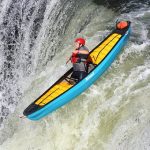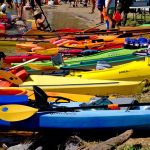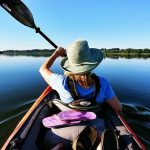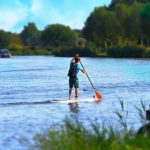River kayaks are designed to be able to quickly maneuver in tight spots with fast currents and waterfalls. Most kayaks have a rounded bottom that makes them easy to maneuver.
They also have a sit-inside design, which means that you sit inside the kayak. The yak’s cockpit is smaller in size and has a spray skirt for keeping water out.
Yaks that are specialized for paddling in the ocean are long and lean, built for quick long-distance paddling. The seats offer lots of space in the bulkhead, and they are narrow to allow a roll.
There is nothing quite like kayaking to get your blood pumping and your heart racing. It is an outdoor activity that can be enjoyed by yourself or with your loved ones, and it is a great way to see the sights or go fishing.
You will need the right yak for the adventure if you want to undertake such a thing. There are several different types of boats out there, each with their own specific design, size, color, etc.
What Are The Main Differences Between River Kayaking And Ocean Kayaking?
There is more to kayaking than just the physical appearance. The main differences between ocean and river kayaking are the design and handling of the kayak, the amount of energy required, the turning radius, the scenery, the amount of adrenaline involved, and the distance from the land.
Choosing a kayak for river paddling is not a simple task, because rivers can differ significantly in character. Which river are you planning to paddle?
The width and current of the river will affect what kind of kayak you should get. Oceans can be huge bodies of water with flat or touring surf zones and huge currents.
Here We Expound More:
Design And Handling
The typical ocean yak is long and designed to move quickly even when facing wind and waves. The biggest challenge with these boats is that they are a bit tippy to handle in rough water but far less prone to capsizing.
If you are going to be kayaking in water that is known to be shaky, make sure that your ocean kayak has a rudder or skeg. A rudder or skeg helps you keep your boat moving in a straight line, especially when there is a lot of wind, and can help you to correct your course if you veer off course.
River kayaks are shortest, with hulls that are flat for quick and responsive maneuvering. To turn in a kayak, shift your weight to the side you want to turn towards.
Many kayakers agree that it is easy to edge a riverboat by simply leaning in a certain direction, and the yak will follow. Before you go kayaking on any river, make sure you know the basics of paddling so you have an easy time.
Energy
You will not have to paddle as much when kayaking downstream because the current will provide most of the energy required to move the boat. Instead, you will be more concerned with steering and maneuverability.
The waves on the ocean may have a lot of energy, but they are not likely to be going in the same direction you want to go. The waves on rivers typically flow straight forward, and kayakers follow this flow.
Ocean kayaking requires the kayaker to use their own energy to move the kayak most of the time. This means that you will need to have more endurance and stamina. In addition, ocean paddling generally covers longer distances, which takes more time.
This is why ocean kayakers are generally in better shape than river kayakers; the sport requires a great deal of endurance.
Turning
River kayaks are shorter and more maneuverable than other types of kayaks, making them easier to turn. While ocean kayaks are designed to go on a straight line, making them difficult to turn.
On the other hand, sit-on-top kayaks are much easier to turn. Since it takes more experience to maneuver ocean boats, beginners may find it challenging.
Scenery
No matter where you go, kayaking will always be surrounded by beautiful nature. Since you have to look for stroke and rapids while kayaking in the river, it often doesn’t allow you to focus much on your surroundings.
Even if there is a lot of diversity and opportunity where you are, you need to make sure you have the basic survival skills you need.
Compared to kayaking in a river or lake, ocean kayaking provides a greater variety of scenery and wildlife to focus on. You can also take an opportunity to stop for a break while relaxing a bit to have lunch on remote beaches.
River kayakers find fulfillment in the opportunity to see incredible waterfalls and beautiful scenery. Kayakers talk about nature as if they are surround by it while they flow down the river.
Adrenaline
If you want to conserve energy when you’re swimming in the ocean, you should paddle slowly and steadily throughout the day. In order to propel yourself forward, you will need to paddle continuously, making it a more endurance-based sport than one that relies on quick bursts of energy.
Paddling in the open ocean will require you to paddle for long distances and extended periods of time. You can feel adrenaline while on the sea during a storm or when there are large waves, but it is more a matter of chance than by design.
Instead of kayaking in the river, one could choose an adrenaline sport that always seems wet and like a roller coaster. You will have the opportunity to challenge yourself against bigger rapids on different rivers. There is also much to learn every day.
For example, when you try to move your boat quickly through dangerous and difficult areas with obstacles like rocks and trees. In short, everything seems fast and furious while kayaking.
Different Types of Kayaks
There are two main types of kayaks, flat water and white water.
Flat Water Kayaks
Flat Water kayaks are designed for paddling on calmer water surfaces such as ponds, lakes, ocean inlets, harbors, and slow-moving rivers. Canoes are designed for use in calm water, but they’re not as boring as you might think!
Some Flat Water kayaks are designed to be able to withstand an occasional large wave, while others are not. This is just one of the many ways that Flat Water kayaks differ from each other.
There are many different types of flat water kayaks, including sit-inside, sit-on-top, touring, sea, and inflatable kayaks. Each type has its own unique features and benefits. They are mostly for relaxed recreational purposes.
Canoes can be a good choice for those who want to explore nature, go fishing, or take scenic tours. They can be accessible to beginners, or serve as good watercraft for those who want to take scenic tours, go fishing, or just explore nature.
Flat Water kayaks have different construction than other types of kayaks. There is wide variation in the size of flat water kayaks, with some designed for larger bodies of water being much bigger than others.
Many other Flat Water kayaks use different seat positions, and some are made of different materials.
White Water Kayaks
If you need a kayak that can go fast, White Water kayaks are a good option. They are designed for use in high-velocity rivers and whitewater rapids. This list includes Play Boats, River Runners, Creek Boats, and Duckies.
White Water kayaks are designed to be highly maneuverable in turbulent waters and can be adapted for trick or performance use.
The kayaks mentioned are able to turn sharply and maneuver well in difficult river conditions.
While they do well in rushing rapids, White Water kayaks may not be the best option for longer trips on steadier waters. They also cannot hold as much as Flat Water kayaks.
As the name suggests, White Water kayaks are built for maneuverability in rough waters White Water kayaks are designed for use in rough waters and are different in size and construction than Flat Water kayaks. Some drones are small and can move quickly, while others are large and can be easier to control.
Sit-Inside Kayaks
Sit-Inside kayaks are based on the traditional kayaks that were used for hunting and transport. Sit-inside kayakers sit in the cockpit, which is located in the hull of the boat.
The cockpit is designed to comfortably fit the user’s legs and cover them up to their waist or midsection. The kayak has a spray skirt to keep water out of the cockpit and off of the user.
Sit-inside kayaks are usually between 8 and 12 feet long, with the most popular recreation lengths being 10 feet. On average, they are 28 inches tall and can hold anywhere from 250 to 300 pounds.
Sit-Inside kayaks are distinguished by their construction. They are not always exclusively Flat Water kayak models.
Some White Water kayaks are technically Sit-Inside kayaks, but it is not uncommon for kayakers to broadly distinguish kayaks between Sit-Inside and Sit-On-Top varieties.
Sit-On-Top Kayaks
“But it’s not going to do me any good on my local lake.” A Sit-Inside kayak may not be ideal for a trip to the local lake. “But I want to relax! Isn’t there a kayak that’s right for that?”
Why, yes, there is. That would be a Sit-On-Top Kayak.
Sit-On-Top kayaks have an open deck, which allows the paddler to sit on top of the kayak hull. The kayaks that are good for beginners are the ones that are popular among people who just want to relax.
Kayaks that are 10 feet long and can hold up to 400 pounds are typically used for this purpose. Sit-On-Top kayaks have hulls that are around 30 to 34 inches wide, which is slightly wider than Sit-Inside kayaks.
Sit-On-Top kayaks are designed so that the user’s legs are above the deck. A Sit-On-Top kayak will probably make you wet, so it’s best to use them in warmer weather.
Folding Kayaks
Kayaks have been used for centuries and come in a variety of shapes and sizes. Folding kayaks have become increasingly popular over the past few years.
Folding kayaks are kayaks that fold up for easy transport and storage. They are made of lightweight materials, so they are easy to carry and pack.
They can be carried like a suitcase and are the size of one when they are folded up.
The great thing about them is that they are new to the market and there are different options to choose from.
Oru Kayak dominates the folding kayak market. The kayaks have features similar to a sit-inside kayak, including bulkheads and storage space.
Oru Kayak has a variety of models, including smaller kayaks, ocean-going kayaks, and tandem kayaks. Weight capacities vary depending on the model.
Tandem Kayaks
Tandem kayaks are a kayak built for two paddlers. This can be a blessing and a curse. The blessing is that you can paddle twice as fast! No matter how quickly you paddle, you won’t be able to outpace your partner.
My wife was not interested in a tandem kayak when we were looking for different kinds. She likes to be independent and have her own adventures. I totally get it… but I digress.
Tandem kayaks are ideal for those who want to take children or pets (or both) out onto the water. Most tandem kayaks are the sit-on-top variety, but there are a few sit-inside models as well.
There are many inflatable kayaks that can accommodate two or more paddlers. Personally, I love the Sea Eagle 380x. This car has a lot of space for two people and their belongings. I can paddle my canoe by myself and have plenty of room for me and my things.
Tandem kayaks are generally less expensive than two solo kayaks.
When looking for a kayak for you and your partner, think carefully about whether a tandem kayak is right for you.
Hybrid Kayaks
A hybrid kayak is a cross between a sit-on-top kayak and a traditional kayak, and offers the best of both worlds. The hybrid kayak is quickly becoming a popular choice for kayakers because it offers the best features of both a sit-on-top kayak and a traditional kayak.
This kayak is a hybrid of a paddleboard and a kayak, and it offers the best features of both.
Paddleboarding is becoming more popular each year, and the hybrid kayak provides people the ability to paddle while also being able to sit when they want.
A paddleboard-kayak hybrid offers the best of both worlds – the large open deck of a SUP combined with the greater paddling performance of a kayak.
Activity ____ has become increasingly popular in recent years due in part to the simple fact that it provides individuals with an opportunity to enjoy being in nature, specifically on open water.




